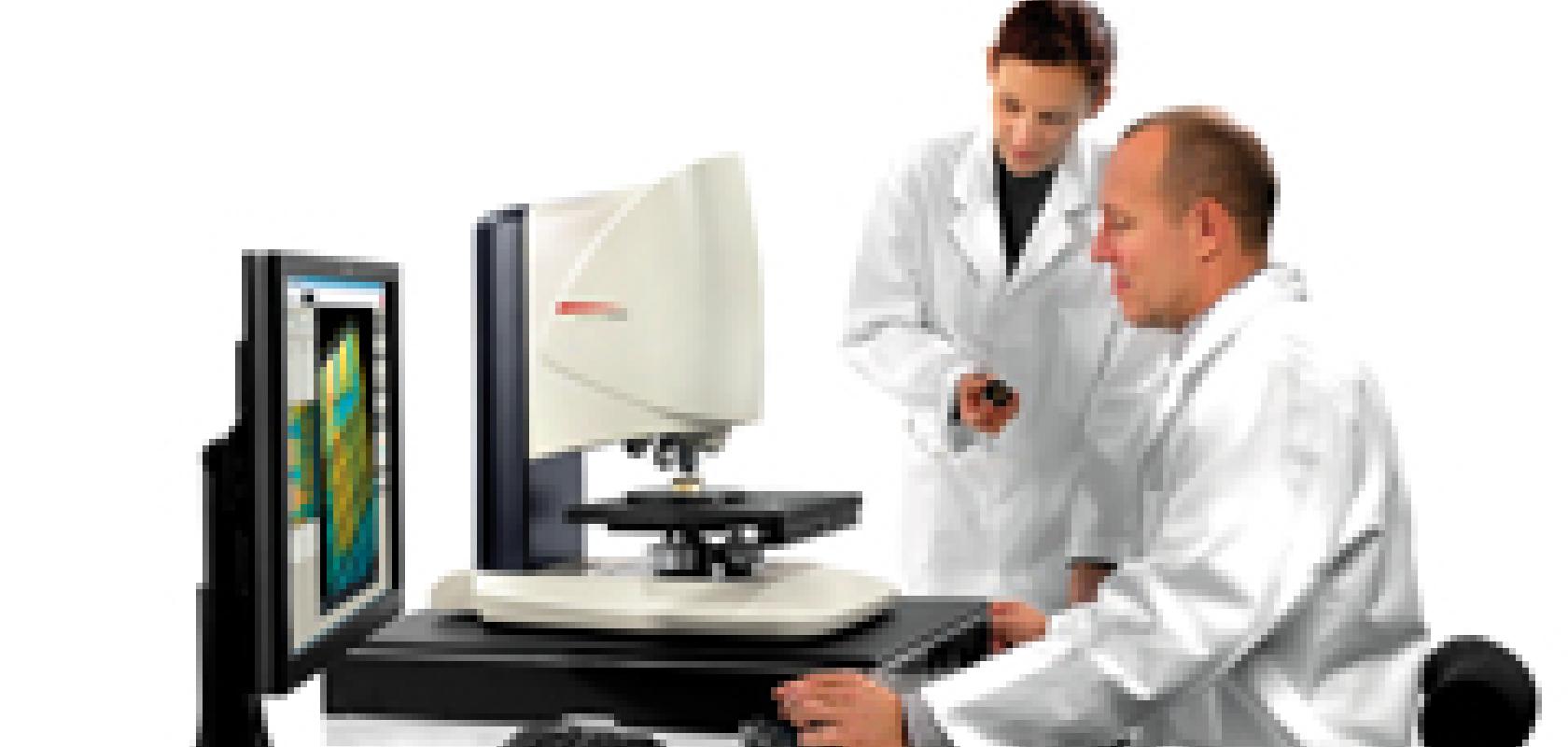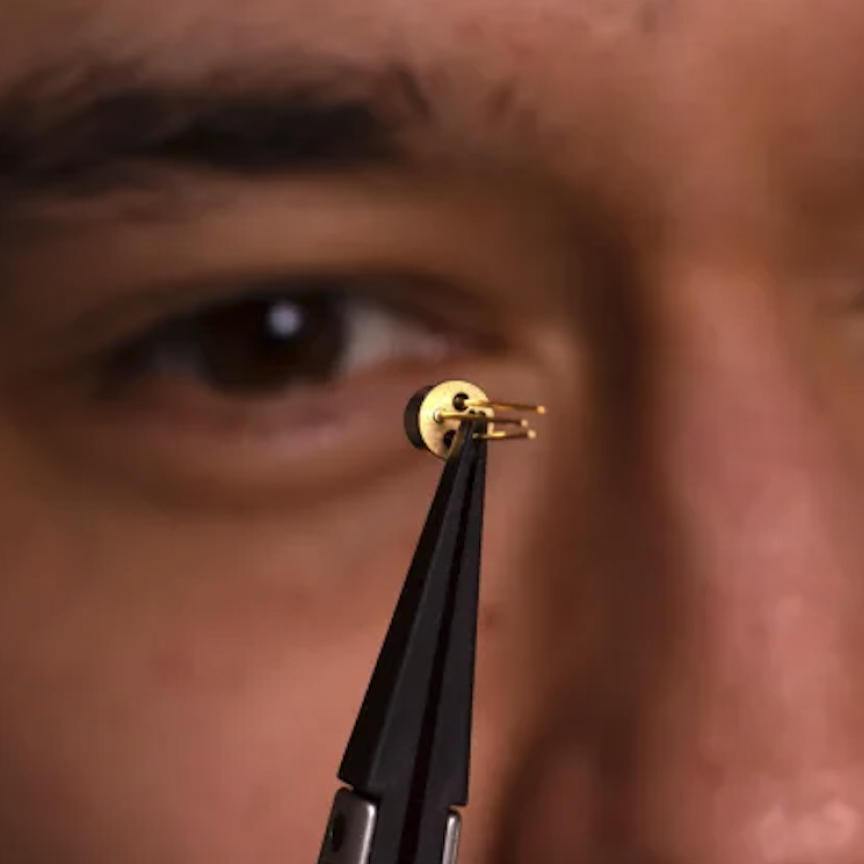Although interferometry may once have been dismissed by the medical community because of its inability to see inside the human body, its application within the wider biomedical arena is continuing to grow and evolve; so much so that the technique is now used in the production of prosthetic limbs, research in dentistry and even for cultivating stem cells.
The surface measurement of medical instruments – particularly medical implants – demands highly precise interferometric techniques, as the tiniest deviation on the surface can affect how such devices perform or react within the human body. Leica Microsystems uses interferometry objectives to measure the surface quality of medical implants such as artificial limbs. In combination with metallography or polarisation microscopes, interferometry is employed to conduct manual measurements of step heights of less than 1nm on a variety of surfaces. Leica’s DCM8 optical surface metrology system gives fast and precise measurements of even large surfaces to obtain a 3D image within a few seconds.
Stefan Motyka, marketing manager at Leica Microsystems, said: ‘In the production of prostheses or artificial limbs, the surface quality of the parts plays an important role to ascertain functionality and for the tolerance of such parts by the human body.’
Interferometric imaging relies on the surface reflectivity of the parts being examined, and this can differ greatly between samples. Conventional interferometric microscope objectives are designed for a specific reflectivity, which means the lens has to be changed for samples that reflect light differently. Leica has developed multi-reflectance interferometry objectives to overcome this. Users can adapt to each sample reflectivity by turning a ring on the objective lens that alters a filter. ‘This optimal adaption to the sample’s reflectivity allows highly precise measurements,’ Motyka added.
Say cheese
Interferometry is also aiding research into the biomechanics and deformation behaviour of dental tissue, or dentine. This type of research will be important in the future for producing dental implants that can better mimic and function like real human teeth.
Researchers at the University of Toronto have used interferometry to determine the changes in the strain value and strain distribution in different regions of interest on dentine specimens. The samples were exposed to physiologically relevant loads during testing and the researchers also conducted experiments to determine the degree of residual strain formed on the dentine after certain clinical procedures.
Dr Anil Kishen, professor and discipline head at the Faculty of Dentistry, University of Toronto, told Electro Optics: ‘Interferometry techniques have been used in investigations on the deformation gradients of enamel and dentine. [These] showed the unique in-plane deformation patterns in the axial and lateral directions. They were used to study temperature induced changes in dentine, drying induced strains in dentine, chewing force induced strains and instrumentation induced strains in the dentine.’
The research, which is funded by the Canadian Foundation of Innovation (CFI) and the Natural Sciences and Engineering Research Council of Canada (NSERC), uses a customised digital moiré interferometer to build an overall picture of dental strain information. In one such experiment, diffraction gratings (with a frequency of 1,200 lines/mm) are transferred onto sagittal sections (a vertical section dividing the tooth into left and right sides) of human teeth. Loads ranging from 10N to 200N are applied to the cutting edge of the tooth. The acquired digital moiré fringe patterns are used to determine the in-plane deformation pattern in the enamel and the dentine in the direction parallel to the long axis (axial direction) and in the direction perpendicular to the long axis (lateral direction) of the tooth.
Similar interferometric studies have investigated the thermal strain gradients on dental hard tissues on localised heat and cold applications, applied to assess the vitality of the pulp – the area in the centre of a tooth, which is made up of living connective tissue and cells called odontoblasts. The role of hydration on the thermal strain distribution within the enamel, dentine, and dentineo-enamel junction was examined using digital moiré interferometry.
Interferometry holds many advantages over conventional mechanical techniques for dentine deformation investigations. For example, mechanical testing applies a large level of compressive, tensile or cyclic loads to the specimens, destroying them at the end of the test whereas, with interferometry, specimens can be reused. Conventional techniques are also limited to studying the spatial variation in material characteristics of dental hard tissues, but interferometry can measure minute deformations of solid structures, caused by mechanical forces, temperature changes, or other environmental changes.
Kishen said: ‘It is a non-destructive, real-time experimental technique and provides whole field strain information, which is able to offer analysis in the specific area of interest.’
However, interferometry also provides some challenges for the researchers as it is sensitive to environmental factors; therefore a vibration isolation setup is required. In addition, although interferometry allows specimens to be reused, this aspect needs to be managed carefully. The interaction between virtual grating and specimen grating generates interferometric fringes, which provides information on how the specimen is deforming. The grating material thus needs to be replicated on the dentine specimens using epoxy adhesive. This can cause issues as, firstly, the moisture in dentine tissue would damage the grating material during replication, and so the moisture control during this process needs to be well handled. Secondly, the application of pressure during grating replication can easily generate residual strain in the dentine specimens. Kishen added: ‘For this issue, different pressure application methods have been tested to determine the most suitable method to avoid generating residual strain, and by developing baseline fringe subtraction methods to minimise errors.’
Interferometry will continue to play an important role in these biomechanical experiments, as Kishen added: ‘One research focus in our lab is to study the causes of increased fracture prediction in root canal treated teeth, and develop a novel approach to enhance their mechanical integrity.’
Stem cell imaging
Apart from ensuring accurate and better performing medical devices, interferometry is also being used at the cutting edge of medical research. A team of scientists from the University of Huddersfield and the University of Loughborough has developed an optical interferometer for improving the reliability of the large-scale production of high-quality stem cells.
The interferometer monitors the production of stem cells that are being grown in liquid on tiny polymer spheres within a large chamber, known as a bioreactor. The spheres are used as micro-carriers to increase the number of surfaces on which the stem cells can grow. The scientists are investigating interferometry as a possible method to monitor the cell growth and, therefore, maximise the yield and quality of the stem cells produced.
The Linnik interferometer is immersed in the growth medium and takes images as the tank is stirred. The measurement arm is submersible and the interferometer is sourced by a superluminescent diode, running in the infrared, with the images captured by a CCD camera. Images are built up by measuring light reflecting from the polymer spheres.
The research has taken place in two stages. Firstly, the apparatus was used to perform static micro-carrier imaging; then the research looked at investigating a moving environment as the liquid in the bioreactor is stirred. This is achieved by swapping the superluminescent diode with a high power pulsed laser diode source.
Dr Haydn Martin, senior research fellow at the University of Huddesfield’s EPSRC Centre for Innovative Manufacturing in Advanced Metrology, said: ‘The reference arm is in air and the measurement arm is in water with a window, so there are a couple of different index changes. We had to design a stage on the reference arm to compensate for the path lengths. From an engineering point of view, that was the trickier element.’
A paper is on the way covering the findings of the static imaging results. The key element for investigation is confluence – looking at how well covered the micro-carriers are with stem cells to optimise the system. Martin said: ‘This is because there is a point where you will want to add more stem cells, but you do not want to do this too early because you will slow the process down. You don’t want to do it too late either, because this will not be efficient.’
The research is currently in the latter stages as the team continues to investigate imaging micro-carriers within a moving environment. The images are now being analysed to see how well the process could be automated. Martin added: ‘This is very much a feasibility study, but eventually the vision for this is that it will be a system that is automated and able to monitor these processes and the cell growth as part of a control loop.’
Other factors, such as the morphology of the cells and carrier aggregation also need to be investigated to improve the efficiency of the process, Martin added.
He concluded ‘If these [stem cell] therapies are rolled out across generations, then we will need billions upon billions of these cells and the amount of industrial scale-up required to do that means you have to have automated process control.’
The interferometric technique optical coherence tomography (OCT) has its limits – it can only image tissue at depths of up to 1mm – but it has found applications in retinal imaging because, unsurprisingly, it is quite easy to shine light through the eye.
OCT uses interferometry to create cross-sectional views of different types of tissue. The technique takes broadband light from a single source and splits it into two arms: one is kept as a reference and the other directed at a target sample. Combining the reflection from the light shone at the sample with that in the reference arm creates an interference pattern, known as an interferogram. There are two basic forms: time domain OCT, where the reference mirror moves; and Fourier domain OCT, where the reference mirror is fixed so that the path length between the mirror and the top or bottom of the sample are matched.
The non-invasive technique is used to detect and monitor morphological changes in the ocular tissue, in particular retinal layer thickness. This can give insights into conditions such as glaucoma, age-related macular degeneration or diabetic retinopathy.
Eric Buckland, CEO at Leica Microsystems company Bioptigen, told Electro Optics: ‘OCT images are well tuned to differentiating the physiologic structures of the retina, and resolve all of the major tissue layers that are part of the visual cycle of the eye. For example, we can resolve the retina pigment epithelium, the photoreceptor layers, and the nerve fibre layer that transmits the visual signal through the optic nerve to the brain.’
The structure of the retina as visualised by OCT matches histology, and is well known. Pathological conditions – such as trauma or disease – of the retina are easily distinguished from normal tissue.
Bioptigen provides a handheld OCT scanner that can be brought to the patient, in contrast to conventional tabletop scanners. Buckland said: ‘OCT is now a standard of care. The Bioptigen system is used in this way to image newborn babies to help physicians diagnose the specific diseases associated with newborns, including retinopathy of prematurity and retinoblastoma, a leading cause of blindness in children.’
A key benefit of OCT is that it is minimally invasive, provides resolutions at the level of cellular tissues, and the axial resolution is decoupled from the lateral resolution. As such, OCT provides superior axial resolution and a depth-resolved volumetric image very quickly. Buckland added: ‘OCT can acquire a 1,000 x 100 x 1,000 pixel image in three seconds. Compared to ultrasound, OCT is non-contact, and has resolutions 50 to 100 times finer.’


